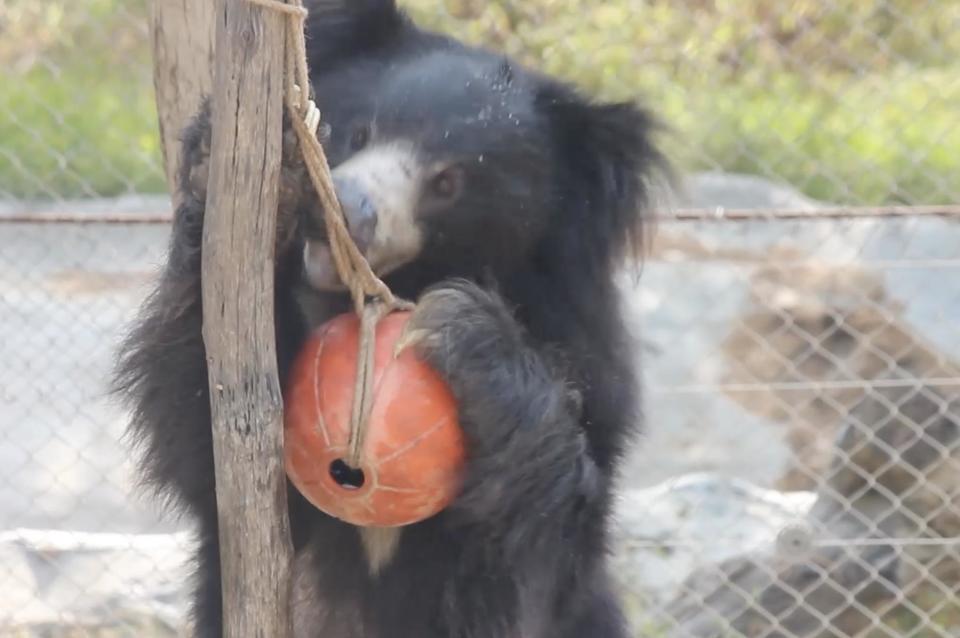Rescued 'dancing bear' explores new home in sanctuary after successful quarantine
The first endangered sloth bear to be rescued across international borders has left quarantine and is adjusting well to his new home at a sanctuary in India.
Rangila, a 19-year-old male, was terrified, underweight and suffering liver problems when he arrived at the Wildlife SOS bear sanctuary outside Agra in July.
It’s hardly surprising, given the traumatic life he has led. As a former “dancing bear,” Rangila was likely snatched from his mother as a cub, had his sensitive muzzle pierced with a hot poker and a rope passed through it.
His trainer would then make him stand up on his hind legs and “dance” to entertain passers-by and tourists – when in fact he was in immense pain.
The trade is illegal in India and improved enforcement of the law led animal rights activists to declare it extinct in 2009. But some bears remain in captivity, hidden away in remote parts of the country, and are being smuggled out to Nepal – where dancing bears are still prevalent – or into the bile industry.
Rangila, along with another bear named Sridevi, was being taken out of India by smugglers in late 2017 when welfare groups were tipped off by informants. They were too late to stop them crossing the border, and though the Nepali police stepped in to rescue the two bears, Sridevi died while they were being held in limited facilities at Kathmandu Zoo.
“They couldn’t provide specialised treatment. That made it even more urgent for us to get Rangila back,” said Arinita Sandilya, a Wildlife SOS advocacy officer.
It took the efforts of a whole network of welfare groups, months of negotiating with two governments and a 30-hour drive in Wildlife SOS’s bespoke animal ambulance, but on 11 July Rangila reached his new home.
After what happened to Sridevi, the most important thing to address was his health. Vets were worried that a lifetime of mistreatment and inappropriate foods had put a strain on Rangila’s liver.
He was immediately put on a diet rich in fruits and nuts, as well as vitamin and mineral supplements, and in three months gained 10kg.
He has also shed his shaggy old coat and replaced it with a shiny, dense one in time for winter, a good sign for his improving health.
Now that his medical quarantine is over, keepers are allowing Rangila to interact with other bears – only through a small gap in the door, for now – and to explore a wider outdoor enclosure.
During a recent visit to the sanctuary by The Independent, Rangila was in his den, wolfing down bananas as fast as his keepers could peel them.
Ms Sandilya said he is “a real foodie” and at his happiest when he is playing with his “enrichments” – items introduced to his enclosure to satisfy his curiosity and simulate natural food-gathering behaviour.
“He was so apprehensive at first and he’s still very wary of strangers. But with the enrichments he started playing almost immediately,” Ms Sandilya said.
She gestured towards the first toy Rangila was given, a perforated ball which the keepers stuffed with dates and then suspended from a pole. “It was remarkable, because he had never seen anything like this before – he had never had the chance to play with anything.
“So he completely lost it when he saw this, he was so excited. We have introduced other enrichments since but, even now, the ball is his favourite.”
There are still signs of what he has been through, however. When his food ran out, Rangila turned to face the wall and started rhythmically swaying his head from side to side, as though trying to exercise as much as possible but unable to move his paws.
His behaviour is not that of a healthy bear – and it likely never will be. Keepers call this “stereotyping”, a physical manifestation of the mental trauma from almost two decades in brutal captivity. Similar patterns of behaviour were seen in other bears in the centre, some of whom had been living in the safety of the sanctuary for many years.
Wildlife SOS’s sanctuaries across India provide homes for more than 300 former dancing bears, and the charity has rescued almost 630 in all.
Despite declaring the practice over in 2009, they still get new bears to care for – the most recent before Rangila being a cub called Mowgli whose mother was killed by an electric wire trap set by poachers.
There are estimated to be fewer than 20,000 wild sloth bears left across India, Nepal and Sri Lanka. Habitat loss and poaching mean the population is decreasing, and they have been officially declared a “vulnerable” species. There are no bears left at all in Bangladesh.
It’s what makes the international rescue of Rangila so significant. Activists hope his case will inspire more action against the dancing bear trade in other countries, with the sanctuaries in India able to take the burden of re-homing the animals.
“There’s still a very long way to go with him [Rangila],” Ms Sandilya said. “He’s still not OK with people and it will be a couple of months before he can fully interact with other bears.
“But to be able to make a difference like this, it was such a big project for us, because we generally don’t see cases like this [anymore].
“Had we not been able to trace him [at the border], he would have been lost, and he would have been part of that [dancing bear] trade again in Nepal. For the rest of his life, that’s what he would have faced.”


